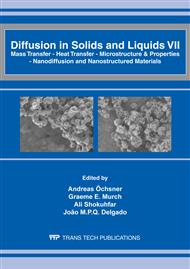p.354
p.360
p.366
p.372
p.377
p.383
p.388
p.394
p.400
Effect of Salt Bath Composition on the Chromium Diffusion on Plain Carbon Steels by TRD Process
Abstract:
The thermo-reactive diffusion (TRD) process is used for diffusing an element to the metallic steel substrate. TRD is carried out by using either salt bath or fluidized bed methods. In this research, the molten salt bath method is used. Ferro chromium was dissolved in the molten borax as the source of chromium in the salt. Samples of cylindrical shape of plain carbon steel with 10 mm diameter and 20 mm height were treated at 1000°C for 14 hours in different baths including either low carbon ferro chromium (LCFC) or high carbon ferro chromium (HCFC) powder. The purpose of this research is to investigate the effect of the salt bath composition on the diffusion of chromium and formation of chromium compound layer on plain carbon steel by using the salt bath method. The coating thickness layers were measured by SEM. The different phases formed on the samples, due to different amounts of carbon in treating salt bath, were determined by X-ray diffraction. It was found that in molten borax salt with high carbon content (high carbon ferro chromium) very few amount of chromium diffused into the plain carbon steel. The thickness of the diffused chromium layer in low and high carbon content ferro chromium in molten borax, is around 32±8 µm and 6.8±1.2 µm, respectively. A number of tests were conducted to address this effect.
Info:
Periodical:
Pages:
377-382
Citation:
Online since:
April 2012
Authors:
Price:
Сopyright:
© 2012 Trans Tech Publications Ltd. All Rights Reserved
Share:
Citation:


